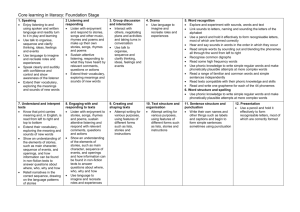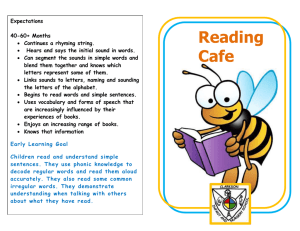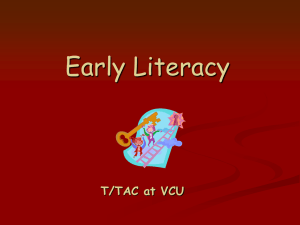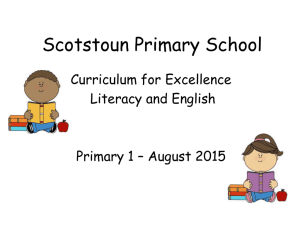Area of Learning – Communication, Language and Literacy
advertisement
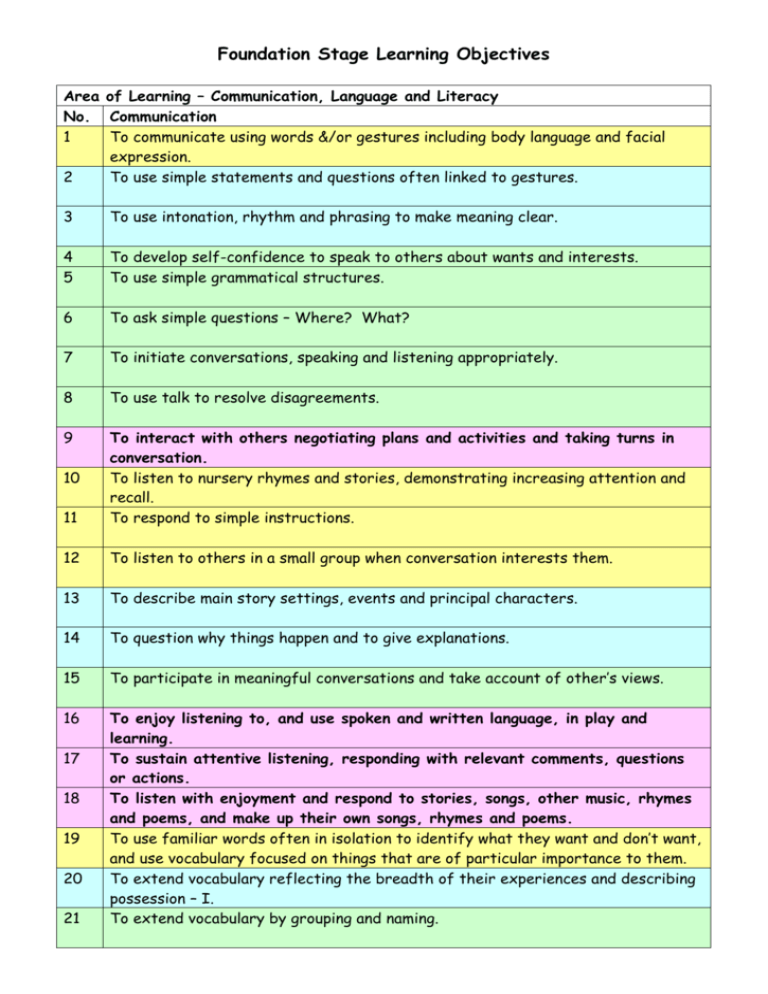
Foundation Stage Learning Objectives Area of Learning – Communication, Language and Literacy No. Communication 1 To communicate using words &/or gestures including body language and facial expression. 2 To use simple statements and questions often linked to gestures. 3 To use intonation, rhythm and phrasing to make meaning clear. 4 5 To develop self-confidence to speak to others about wants and interests. To use simple grammatical structures. 6 To ask simple questions – Where? What? 7 To initiate conversations, speaking and listening appropriately. 8 To use talk to resolve disagreements. 9 11 To interact with others negotiating plans and activities and taking turns in conversation. To listen to nursery rhymes and stories, demonstrating increasing attention and recall. To respond to simple instructions. 12 To listen to others in a small group when conversation interests them. 13 To describe main story settings, events and principal characters. 14 To question why things happen and to give explanations. 15 To participate in meaningful conversations and take account of other’s views. 16 To enjoy listening to, and use spoken and written language, in play and learning. To sustain attentive listening, responding with relevant comments, questions or actions. To listen with enjoyment and respond to stories, songs, other music, rhymes and poems, and make up their own songs, rhymes and poems. To use familiar words often in isolation to identify what they want and don’t want, and use vocabulary focused on things that are of particular importance to them. To extend vocabulary reflecting the breadth of their experiences and describing possession – I. To extend vocabulary by grouping and naming. 10 17 18 19 20 21 Foundation Stage Learning Objectives Area of Learning – Communication, Language and Literacy No. Communication continued… 22 To use vocabulary influenced by experience of books – ‘once upon a time’. 23 To extend vocabulary exploring the meanings and sounds of new words. 24 To use isolated words and phrases to communicate with familiar people. 25 To use more complex sentences and vocabulary and use language to express ideas. 26 To link statements and stick to a main theme or intention, and use language for an increasing range of purposes. To confidently talk to less familiar people. 27 28 No. 29 To speak clearly and audibly with confidence and control, and show awareness of the listener (eg, by using conventions - greetings, please and thank you). Language For Thinking To use action and limited talk to communicate (the here and now). 30 To talk activities through, reflecting on and modifying what they are doing. 31 32 To use talk to give new meaning to objects and actions, treating them as symbols for other things. To use talk to connect ideas (eg, what is happening, what might happen next?) 33 To use talk, actions and objects to recall past experience. 34 To use talk instead of action to rehearse, record and reflect on past experience. 35 To begin to link cause and effect, sequencing, ordering and grouping. 36 To begin to use talk to pretend imaginary situations. 37 To use language to imagine and recreate roles and experiences. 38 No. 39 To use talk to organise, sequence and clarify thinking, ideas, feelings and events. Linking Sounds and Letters To enjoy rhyming and rhythmic activities, and distinguish one sound from another. 40 To show an awareness of rhyme, alliteration and rhythm. Foundation Stage Learning Objectives Area of Learning – Communication, Language and Literacy No. Linking Sounds and Letters 41 To recognise rhythm in the spoken word. 42 To continue a rhyming string. 43 To hear and say the initial sound in words, and know which letters represent some of the sounds. To hear and say initial and final sounds in words, and short vowel sounds within words. To link sounds to letters, naming and sounding the letters of the alphabet. 44 45 46 No. 47 To use phonic knowledge to write simple regular words, and make phonetically plausible attempts at more complex words. Reading To listen and join with stories and rhymes in a 1-1 or a small group situation. 48 To show interest in illustrations in books and the environment. 49 To handle books carefully. 50 To know that information can be relayed in the form of print. 51 To hold books the correct way up, and turn pages. 52 To understand the concept of a word. 53 To recognise some familiar words and enjoy an increasing range of books. 54 To know that information can be retrieved from books and computers. 55 To explore and experiment with sounds, words and texts. 56 To retell narratives in the correct sequence, drawing on language patterns of stories. To read a range of familiar and common words, and simple sentences independently. To know that print carries meaning, and in English, is read from left to right, and top to bottom. To show an understanding of the elements of stories, such as main character, sequence of events, openings, and how information can be found in non-fiction texts. 57 58 59 Foundation Stage Learning Objectives Area of Learning – Communication, Language and Literacy No. Writing 60 To draw and paint, sometimes giving meaning to marks. 61 To use some clearly identifiable letters to communicate meaning. 62 To begin to break the flow of speech into words. 63 To represent some sounds correctly in writing. 64 66 To use phonic knowledge to write simple regular words, and make phonetically plausible attempts at more complex words. To attempt writing for different purposes (eg, lists, stories and instructions). To write own name, and other things such as labels and captions. 67 To begin to form simple sentences, sometimes using punctuation. No. 68 Handwriting To participate in activities involving hand/eye co-ordination. 69 To use one handed tools and equipment. 70 To draw lines and circles, using gross motor movement. 71 To manipulate objects with increasing control. 72 To begin to use anti-clockwise movements, and retrace vertical lines. 73 To begin to form recognisable letters. 74 To use a pencil, and hold it effectively to form recognisable letters, most of which are correctly formed. 65





